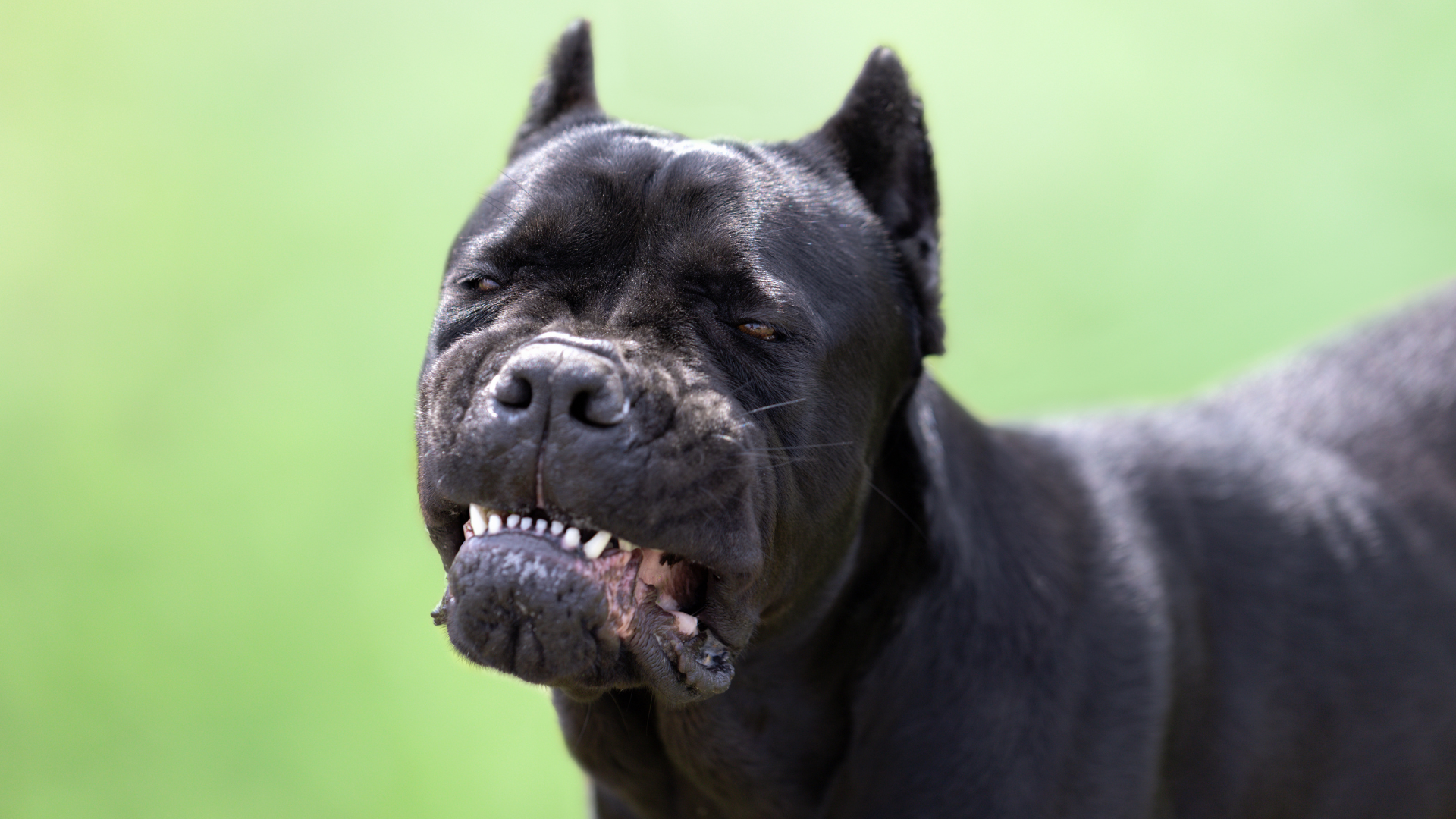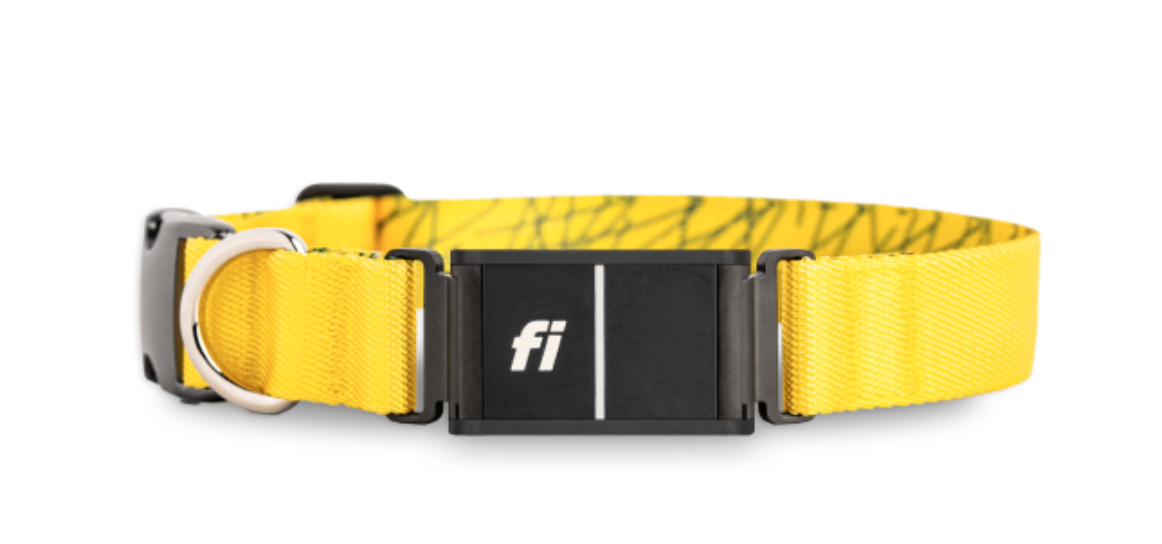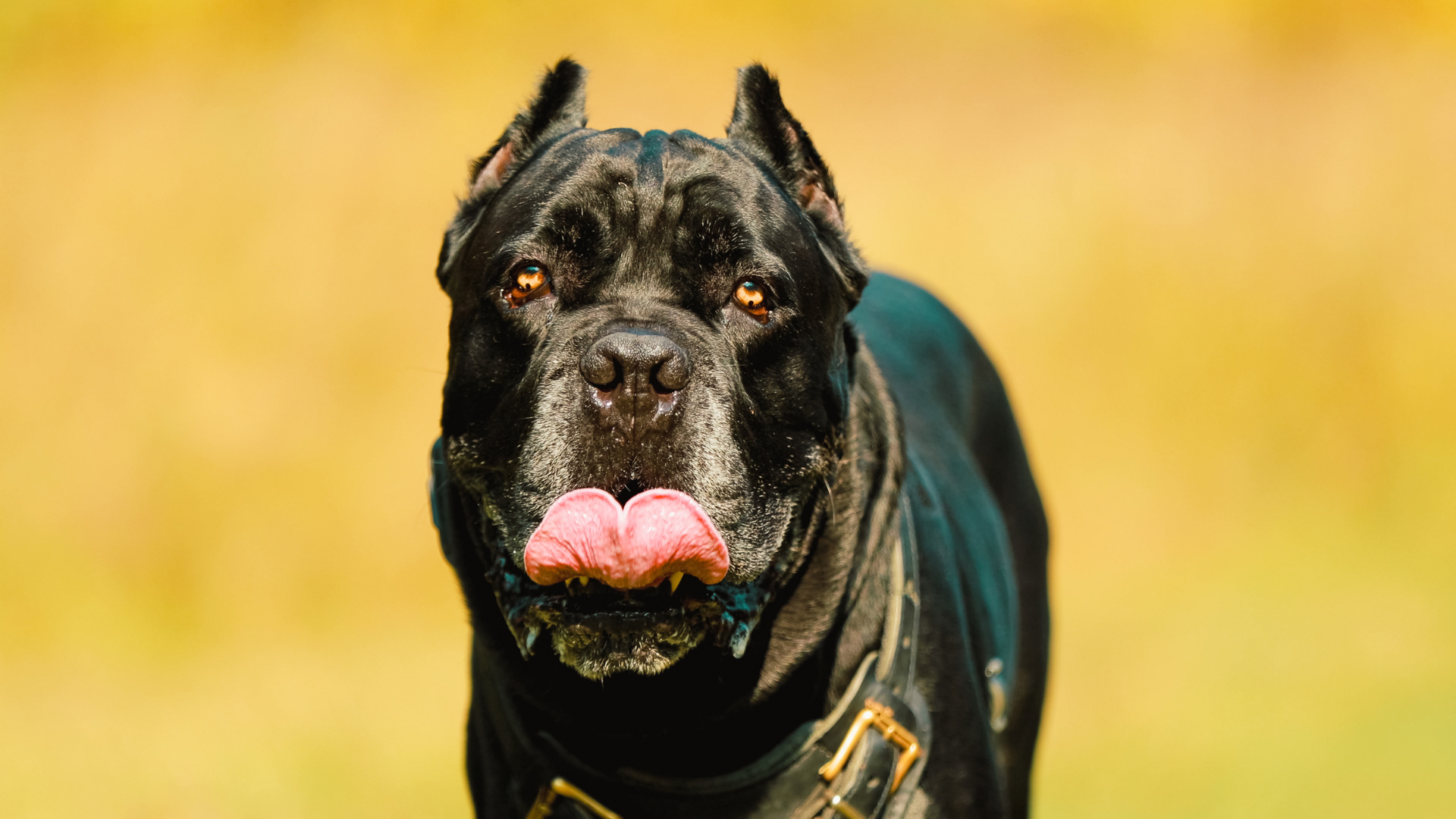The Cane Corso is a large and powerful breed of dog that originated in Italy. Known for their muscular build and imposing presence, these dogs are often used for protection and guarding. One aspect of the Cane Corso that is frequently discussed is its bite force.

According to various sources, the Cane Corso has a bite force of around 700 PSI (pounds per square inch). This is a relatively high bite force compared to other dog breeds and is often attributed to the breed's strong jaw muscles. However, it's crucial to note that bite force can vary depending on factors such as the individual dog's size, age, and health.
Despite their reputation for having a strong bite, it's important to remember that any dog has the potential to bite if they feel threatened or provoked. Proper training and socialization can help control aggressive behavior in Cane Corsos and other breeds. Understanding the capabilities and tendencies of different dog breeds, including their bite force, can help promote responsible pet ownership and prevent incidents of dog bites.

Understanding Bite Force
The bite force is a crucial aspect of a dog's anatomy, particularly for breeds like the Cane Corso. It refers to the amount of pressure that a dog can exert with its jaws and teeth. Here, we will explore the measurement of bite force and how it compares to other breeds.
Measurement of Bite Force
The bite force is typically measured in pounds per square inch (PSI) using a device called a bite force sensor. This device is placed between the dog's jaws, and the dog is encouraged to bite down with as much force as possible. The sensor then records the amount of pressure exerted by the dog's jaws.
The average bite force of a Cane Corso is around 700 PSI, which is higher than many other dog breeds. However, it is vital to note that the strength of a dog's bite force is not solely determined by its breed. Factors such as the size of the dog, the shape of its jaw, and its strength and power also play a role.
Comparative Analysis With Other Breeds
When compared to other dog breeds, the Cane Corso's bite force is quite impressive. However, several other breeds also have a high bite force. For example, Rottweilers, Mastiffs, Kangals, German Shepherds, Doberman Pinschers, and Pit Bulls are all known for their powerful jaws and high bite force.
It is essential to note that just because a dog has a high bite force does not mean that it is more dangerous or aggressive. The bite force is just one aspect of a dog's behavior and should be considered in conjunction with other factors such as temperament, socialization, and training.

Cane Corso's Bite Force
Cane Corso is a muscular and robust breed known for its impressive bite force. Here, we will explore the factors that influence their bite force and how it comes into play during various situations.
Factors Influencing Bite Force
The bite force of a Cane Corso is influenced by several factors, including the size and muscular build of the dog, the structure of its jaw and skull, and the strength of its jaw muscles and bones. The Cane Corso's jaw structure is designed for maximum strength, with a broad and square-shaped muzzle that provides ample space for powerful jaw muscles to attach. Additionally, their skull size and shape allow for a strong bite force, making them well-suited for hunting and guarding.
Cane Corso Bite Force in Action
When it comes to prey drive and protective nature, the Cane Corso's bite force is a crucial aspect. Their instincts and prey drive make them excellent hunters, and their protective nature makes them ideal for guarding. In both cases, their bite force comes into play when they need to subdue prey or protect their territory.
Thus, the Cane Corso's bite force is a result of several factors, including their muscular build, jaw strength, and skull structure. Their instincts and protective nature make them well-suited for hunting and guarding, and their impressive bite force is a crucial aspect in both situations.
Behavioral Aspects
Cane Corso is a breed of dog that is known for its loyalty and protective nature. However, these dogs can also exhibit aggressive tendencies if not properly trained and socialized. Here, we will discuss the behavioral aspects of Cane Corso, including their training and socialization needs and their tendency towards aggression and bite incidents.
Training and Socialization
Training and socialization are essential for any dog, but they are particularly significant for Cane Corso. These dogs are big and mighty, and without proper training, they can become difficult to handle. Positive reinforcement and obedience training are recommended for Cane Corso, as they respond well to these techniques.
Early socialization is also crucial for Cane Corso. They should be exposed to various people, animals, and environments from a young age to prevent fear and aggression. Training techniques such as desensitization and counterconditioning can help Cane Corso learn to be calm and relaxed in different situations.
Fi GPS Tracking Dog Collar
Fi GPS tracking Dog Collar is ideal for helping keep your Cane Corso in the best shape. It enables you to track the dog's exertion levels and steps, which you can compare to other dogs of similar breeds within your neighborhood.

These tracking collars come in four core colors: pink, blue, gray, and yellow. They're a perfect fit for dogs whose neck sizes range between 11.5 and 34.5 inches. With its GPRS tracking feature, you'll instantly get a phone alert if your pup friend ever gets out unexpectedly.
Aggression and Bite Incidents
Cane Corso has a reputation for being a dangerous dog, and this is partly due to their aggressive tendencies. However, it is significant to note that not all Cane Corso are aggressive, and many are friendly and well-behaved with proper training and socialization.
Bite injuries from Cane Corso can be severe due to their strong bite force. Therefore, it is crucial to control aggressive behavior and bite incidents. Owners should be aware of the signs of aggressive behavior, such as growling, snarling, and lunging, and take steps to prevent these behaviors from escalating.
Hence, Cane Corso is a breed that requires proper training and socialization to prevent aggressive tendencies and bite incidents.
Health and Safety
Preventing Unwanted Biting
Cane Corso dogs are known for their rugged jaws and high bite force, so owners need to take measures to prevent unwanted biting. One way to do this is by providing proper exercise and mental stimulation to the dog. Regular exercise not only keeps the dog physically healthy but also helps to release any pent-up energy that could lead to aggressive behavior. Mental stimulation, such as training and interactive toys, can also help to keep the dog mentally stimulated and less likely to engage in destructive or aggressive behavior.
Another significant aspect of preventing unwanted biting is responsible ownership and management. Owners should always supervise their dogs when around children or other animals, and should never leave them unsupervised in public areas. It is also needed to provide proper training and socialization to the dog from a young age. It can help to prevent any aggressive behavior from developing in the first place.
Dealing With Bite Injuries
Despite all precautions, bite injuries can still occur. In the event of a bite, it is crucial to seek medical attention immediately. Cane Corso dogs have a strong bite force that can result in puncture wounds and other serious injuries. It is required to clean the wound properly and seek medical attention to prevent infection.
To measure the bite force of a Cane Corso, a bite meter can be used. This device measures the amount of force exerted by the dog's bite and can help determine the severity of any potential injuries. Additionally, there are K9 bite bars that can be used for training and testing purposes. These bars are designed to withstand the force of a dog's bite and can help to prevent any injuries to humans.
Overall, responsible ownership and management are key to preventing unwanted biting and ensuring the safety of both the dog and humans. By providing proper exercise, mental stimulation, and training, owners can help to stop any aggressive behavior from developing.
Cane Corso as a Breed

Breed Origin and History
The Cane Corso is a breed of mastiff that originated in Italy. It is also known as the Italian Mastiff. The breed has a long history of being used as a guard dog, and its protective nature has made it a popular choice for families looking for a loyal and dependable pet. The Cane Corso was originally bred to hunt wild boar and to guard property, and its ancestors can be traced back to ancient Rome.
Physical Characteristics and Anatomy
The Cane Corso is a large and muscular breed, with strong jaws and teeth. They typically weigh between 88 and 110 pounds, with males being larger than females. The breed has a short, dense coat that comes in different colors, including black, gray, and fawn. The Cane Corso has a broad head and a powerful neck, which gives it a distinctive appearance.
The breed's anatomy is well-suited for its role as a guard dog. Its strong jaws and teeth allow it to deliver a powerful bite, which can be an effective deterrent to intruders. The Cane Corso's size and weight also make it an imposing presence, and its protective nature makes it fiercely loyal to its family.
In terms of genetics, the Cane Corso is a relatively healthy breed, with few genetic health problems. However, like all breeds, they can be prone to specific health issues, such as hip dysplasia and bloat. Prospective owners need to do their research and choose a reputable breeder who screens their dogs for these and other health issues.
Comparisons and Myths
Cane Corso vs. Other Guard Dogs
When it comes to bite force, the Cane Corso is often compared to other guard dog breeds such as the Rottweiler, German Shepherd, Doberman Pinscher, Boerboel, Bullmastiff, American Staffordshire Terrier, and Boxer. While these breeds are also known for their power and protective instincts, the Cane Corso's bite force is often considered to be one of the strongest.
According to a study conducted by National Geographic, the Cane Corso's bite force measures at around 700 PSI (pounds per square inch), which is comparable to the bite force of a lion or a grizzly bear. However, it is vital to note that bite force is not the only factor that determines a dog's strength or aggression.
Dispelling Common Misconceptions
There are several myths surrounding the Cane Corso's bite force that need to be dispelled. One common misconception is that the breed has a "lockjaw" that makes it difficult to release its bite. However, this is not true. Like any other dog, the Cane Corso can be trained to release its bite on command.
Another myth is that the Cane Corso is a fighting dog or a dangerous breed. While it is true that the breed was originally bred for hunting and protection, it is not inherently aggressive or dangerous. Like any other dog, its behavior is largely determined by its upbringing and training.
Finally, some people believe that the Cane Corso should always wear a muzzle because of its strength and protective instincts. While it is needed to take precautions when interacting with any large dog, a well-trained and socialized Cane Corso should not require a muzzle in most situations.
Ownership and Care

Cost of Ownership
Owning a Cane Corso can be a significant financial investment. The initial cost of purchasing a puppy from a reputable breeder can range from $1,500 to $4,000. In addition to the purchase price, there are also ongoing costs such as food, veterinary care, and grooming.
Cane Corsos require a high-quality diet to maintain their health and athleticism. Owners should expect to spend around $50 to $100 per month on food, depending on the brand and quality of the food.
Veterinary care is also an essential aspect of responsible ownership. Regular check-ups, vaccinations, and preventative care can help keep a Cane Corso healthy and detect potential health issues early on. Owners should budget for routine veterinary care as well as unexpected medical expenses.
Grooming is another expense to consider. Cane Corsos have short, dense coats that require minimal grooming, but they do shed. Owners may need to invest in good vacuum and grooming tools to keep their homes and pets clean.

Exercise and Mental Stimulation
Cane Corsos are athletic dogs that require regular exercise and mental stimulation. Daily walks and playtime in a fenced yard are significant for their physical and mental well-being. Owners should also provide opportunities for mental stimulation such as puzzle toys and training sessions.
It is important to note that Cane Corsos can become destructive or develop behavioral issues if they do not receive enough exercise and mental stimulation. They are loyal and intelligent dogs that thrive on attention and interaction with their owners. Therefore, owning a Cane Corso requires a significant financial and time commitment.
Conclusion
The Cane Corso is a remarkable breed with a rich history and impressive physical capabilities. Their bite force, one of the strongest among dog breeds, is a testament to their muscular build and jaw strength. While this characteristic underscores the importance of responsible ownership, it also highlights the distinct qualities that make the Cane Corso a beloved companion for many. With proper care, training, and socialization, these dogs can be loyal, protective, and loving members of any family.






